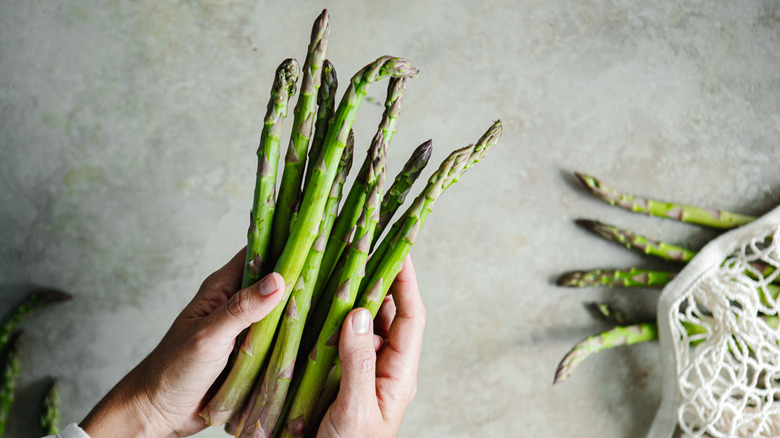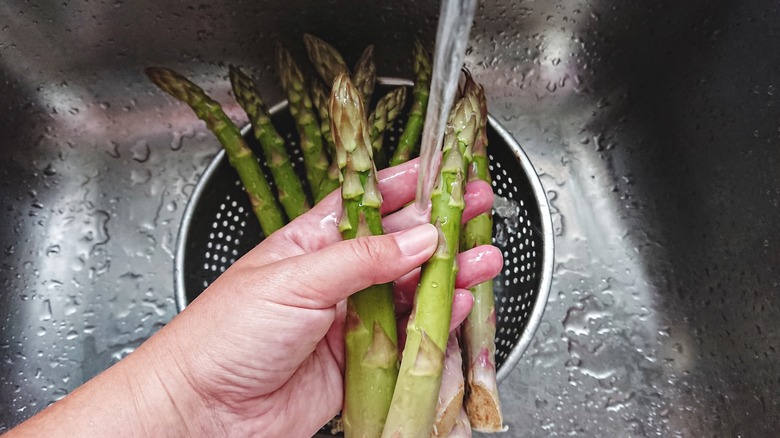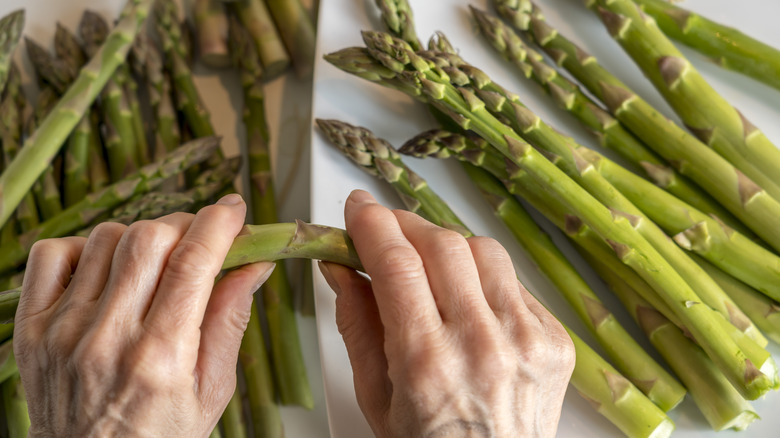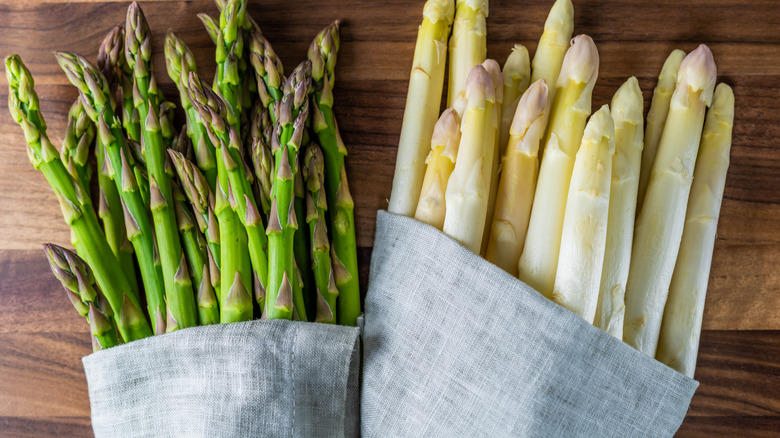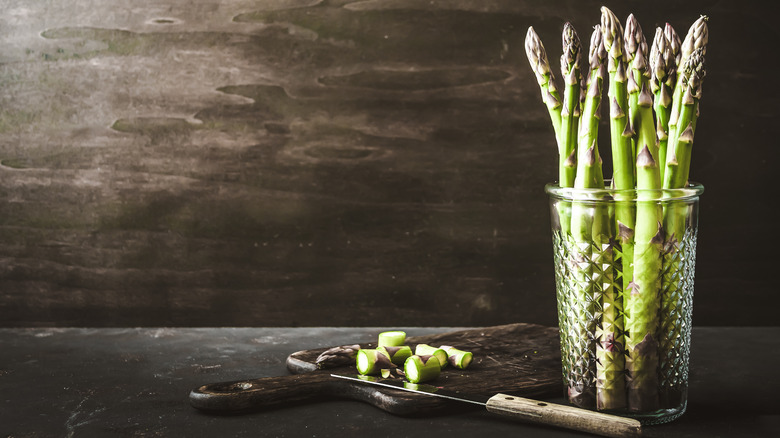How To Clean Asparagus Perfectly Every Time
Chopped into creamy risottos, topped with polenta and burrata, prepared with a side of challah croutons, blended into thick spring asparagus soup, or simply roasted in the oven with a bit of salt — there are tons of recipes that make the most of asparagus. But before you get started on prepping and cooking this nutrient-packed vegetable, it's crucial that you clean the crisp stalks first.
All produce, including asparagus, often comes laced with bugs, dirt, bacteria, and harmful pesticides. Some of these are by-products of outdoor farming. Others are unfortunate pollutants that can contaminate fresh food while it is stored, transported, and stocked on supermarket shelves. Regardless, they can all lead to foodborne illnesses such as E. coli and salmonella if ingested.
Luckily, asparagus is one of the easier vegetables to clean: All you need to do is prep it, wash it, dry it, and maybe degrit it. That said, you'll save yourself heaps of extra work if you pick the freshest possible asparagus from the get-go. When buying asparagus, look for spears that are firm and vibrant no matter their shade — you don't want anything that's limp, squishy, or dull. Choose those whose tips are more densely packed and closed, and stay away from ones that have wrinkles. It's also better to buy asparagus from a store that places the spears upright in a bit of water to keep them from drying up. After you've carefully picked your plump, firm spears, it's time to start cleaning them!
Rinse asparagus under running water
The first thing to do when you're ready to clean the asparagus is to give it a good ol' wash under cold running water for a minimum of 10 seconds. You'll want to do this before you trim, peel, or prep your asparagus in any way, as doing so will prevent bacteria, dirt, and grit from accidentally transferring into the produce through a contaminated knife.
Though cleaning asparagus doesn't require any soap — you only need to hold the spears in your hand under running water briefly — don't be afraid to get your hands dirty if the spears look particularly mucky. Use your fingers to gently dislodge the grime, paying extra attention to those densely packed tops where bacteria can hide.
No matter what you do, be sure to wash your hands with soap and warm water for at least 20 seconds before touching the asparagus — no amount of cleaning will do any good if your hands are dirty.
Prep the asparagus
Once the spears are washed, the next step is to prep them by snapping off the hard, woody bottoms that tend to be tough to eat. One way to do so is to simply run your hands along the spears and bend them where they seem to droop — they tend to inherently have a breaking point from where they will snap off when pressed with a little bit of pressure.
Alternatively, you could also chop off the ends using a knife, which allows you to trim multiple specimens in one go. Doing so will also ensure that you trim precisely how much of the spear you want without snapping off more than you intended to. In general, you'll want to chop off about an inch of the asparagus if it's a thin stalk and two if it's a thick one. When in doubt, however, look at where the stalks begin to become tough or their color starts to fade — that's where you'll want to make the cut to remove the fibrous bits.
Thoroughly dry the asparagus
Rinsed and neatly trimmed, the clean asparagus is ready to be cooked or stored for later use. Before you do that though, make sure that the spears are thoroughly dry first. A damp vegetable is going to be a sad, potentially spoiled vegetable very, very quickly.
To do so, lay the freshly washed spears on a cloth or paper towel in a single layer, using another towel to gently tap them dry. This will not only soak up any excess water on the asparagus that can get in the way of cooking, but it's even more important if you plan on storing the spears for later use. While you do want some controlled moisture to keep the spears from drying up (you could store them upright in a glass with about half an inch of fresh water), you don't want random damp spots to make them rot or turn moldy — it's an asparagus mistake you should avoid.
Store the clean asparagus properly for optimum freshness
Washing asparagus in water isn't always the first step to take if you want to store it. You can simply pop the veg into the fridge, and wash the spears only when they are ready to be cooked. However, there's certainly no harm in washing asparagus before storing it — the order of things is entirely up to you.
Ideally, asparagus is better the fresher it is, but depending on how long you'd like to keep the stems, there are several ways to store them. If you plan to use up the asparagus within a day, wrap the spears in a damp towel, seal them in a ziplock bag, and place them in the vegetable drawer of your refrigerator.
Alternatively, if you'd like to extend their lifespan for longer, use the cup of water method. Loosely cover the spears with a plastic bag and replace the water every time you notice it getting cloudy. Place the jar in a part of the refrigerator that's cold but not freezing, and the spears will stay fresh for anywhere between three to five days.
You could even blanch the asparagus first, as this will help it stay firm and vibrant for longer even when stored in the refrigerator for days. When you do blanch it, however, consider boiling the asparagus upside down to prevent mushy tips.

